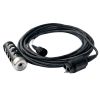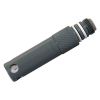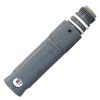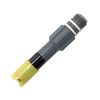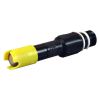YSI Pro1020 pH & Dissolved Oxygen Meter
The YSI Pro1020 provides everything required in a handheld instrument to measure dissolved oxygen, temperature and either pH or ORP.
Features
- User-replaceable cables and sensors provide versatility
- Smart calibration routine allows easy calibration routines
- Graphic backlit display with 50 dataset storage
- Free ground shipping
- Expedited repair and warranty service
- Lifetime technical support
- More
Overview
The YSI Pro1020 provides everything needed in a handheld instrument to measure dissolved oxygen, temperature and either pH or ORP. User-replaceable sensors and cables (sold separately), 50 data set memory, and a convenient calibration routine makes it user-friendly. A true field instrument; Mil-spec (military spec) connectors, IP67 waterproof, rubber over-molded case, and 1-meter drop tests ensure durability to provide years of sampling even in the harshest field conditions.
Benefits
- Available with 1- 4- 10- 20- and 30-m cable lengths standard (cable management kit included on all cables 4-m and longer).
- Large graphic, backlit display and glow-in-the-dark keypad. Usable in any lighting condition. The display is also visible when wearing polarized sunglasses.
- Tough, IP67, impact-resistant, waterproof case. Waterproof without the battery cover as well.
- Multiple languages: English, Spanish, French, and Portuguese.
- Choose either polarographic or galvanic DO sensors.
- Quick response times; 95% DO response time is approximately 8 seconds with the standard membrane (fastest response time in the market).
- 3-year instrument; 2-year cable; 1-year sensor warranty (6-months Galvanic DO).
- Cable Lengths: 1- 4- 10- 20- and 30-m lengths (3.28, 13.1, 32.8, 65.6, and 98.4 ft.)
- Certifications: RoHS, CE, WEEE, IP-67, 1-meter drop test
- Connector: MS (military spec) waterproof with bayonet lock
- Data Memory: 50 data sets
- Dimensions: 8.3 cm width x 21.6 cm length x 5.6 cm depth (3.25 in x 8.5 in x 2.21 in)
- Languages: English, Spanish, Portuguese, French
- Power: 2 alkaline C-cells providing approximately 425 hours of battery life depending without backlight usage; low battery indicator with approximately 1 hour left
- Warranty: 3-year instrument; 2-year cable; 1-year most sensors; 6-month galvanic DO
- Waterproof: IP67 (even with the battery cover off)
- Weight with Batteries: 475 grams (1.05 lbs)
- (1) YSI Pro1020 display
- (1) Operations manual
- (2) C-cell batteries
In The News
Watershed groups handing tech to volunteers for better citizen monitoring
Watershed protection groups across the country are collecting water quality data on waterways that might otherwise miss out on monitoring entirely. Some have found that, despite small staffs, they can compile more high-quality data by putting water quality sensors and other professional scientific instruments in the hands of volunteers. For organizations like the Santa Barbara Channelkeeper, the reasoning for equipping volunteers with electronic handheld meters is clear: "We really want the data that we're collecting to be utilized," said Ben Pitterle, director of the group's watershed and marine program.
Read MoreResearchers pioneer continuous groundwater quality monitoring in Ontario
As a graduate student in Ontario, Jana Levison manually sampled groundwater wells in a hay field for a week straight. Now an assistant professor in the University of Guelph's School of Engineering, Levison is investigating how a new generation of water quality sensors can move the science forward while cutting the labor back. Levison said her doctoral work in a crystalline bedrock aquifer showed monthly variations in nitrate — a common groundwater contaminant often sourced to intensive agriculture — and daily variations in E. coli. Those short-term changes got her interested in watching groundwater in a more detailed manner. "Now we have the equipment that we can do that," Levison said. That equipment includes YSI's EXO multi-parameter sondes and Satlantic's SUNA nitrate sensor.
Read MoreIn Sierra Nevada streams, researchers on the lookout for drought-threatened fish
In the parched hills of the Sierra Nevada, researchers are surveying drought-weakened streams to see what effects long-term dryness is having on fish populations in the region. Their findings so far have been less than stellar, with sparse numbers of fish being counted. Still, as data collection is progressing, the researchers, who work out of the University of California, Davis’ Center for Watershed Sciences, are gathering insights that could aid in conservation efforts that are expected to grapple with coming climate changes. The purposes of the investigation are two-fold. “If we ever get rain again, we want to see how well these areas are recovering from drought,” said Rebecca Quinones, a postdoctoral researcher at the center and leader of the project.
Read More




























